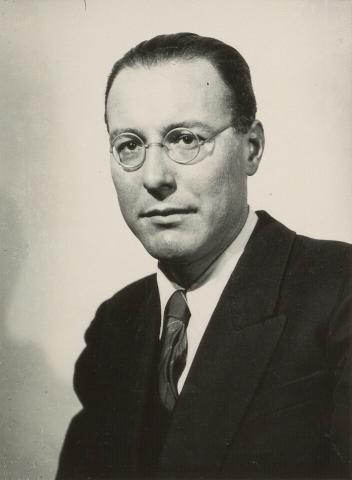Bruno Thomas studied art history at the universities of Vienna and Kiel, where he received his doctorate with a thesis on Die westfälischen Figurenportale in Münster, Paderborn und Minden in 1932. He completed his training at the Institute for Austrian Historical Research with the state examination in 1933. Beginning with a traineeship in 1934, he was a contract employee in the scientific service at the Kunsthistorisches Museum (KHM) Vienna from 1936. In August 1937, Thomas married the art historian Annemarie Güdesen, with whom he was to have two children. After the "Anschluss", he briefly took over the provisional management of the KHM's Imperial Armoury collection (later the Hofjagd- und Rüstkammer) as successor to August Grosz, who had been dismissed for political reasons because his wife Elvira was considered a "Mischling I. Grad" (First Degree "Mixling"/Mischling) in Nazi diction. As early as July 1938, he was demoted to curator, as Leopold Ruprecht, who unlike him was a member of the NSDAP, was appointed head of the weapons collection. From February 1940 until the end of the war, Thomas was a non-commissioned officer in the "Wehrmacht", on whose behalf he researched the archives of the Paris Artillery Museum, together with the curator of the Munich Army Museum Alexander Reitzenstein, with the aim of bringing former Habsburg property back to Vienna. After the objects were transferred to the German Army Museum in Berlin, they then arrived in Vienna as loans from the "Wehrmacht", where they were exhibited in the Neue Burg in the special show Armour and weapons: Repatriations from the Musée de l'Armée in March 1941. The objects were to be returned after the end of the war with the establishment of the "Commission for the Return of Abducted Arms and Armour from France". Even during his time in the "Wehrmacht", Bruno Thomas wished to continue to be active in publishing. He wrote an article about Masterpieces of German Armoury for Polish Pinces in Vienna but was unable to publish it due to the war. In July 1945, Thomas returned from captivity in England and in 1946 began working at the KHM again, first as curator 2nd Class, and from 1951 as curator 1st Class. In 1950, he once again took over the management of the KHM's weapons collection, and two years later that of the weapons collection at Ambras Castle in Innsbruck. From 1954 to 1958, he was in charge of the Collection of Sculpture and Decorative Arts (later the Kunstkammer) and from 1958 until his retirement in 1975, he was Director of the Weapons Collection in Vienna. In 1967, he was appointed Deputy First Director of the Kunsthistorisches Museum.
Bruno Thomas

Kurt Peball, Thomas, Bruno, in: Peter Broucek/Kurt Peball, Geschichte der österreichischen Militärhistoriographie, Köln 2000, 618–622.
Bruno Thomas, August Grósz, Katalog der Waffensammlung in der Neuen Burg, Wien 1936.
Bruno Thomas, Deutsche Plattnerkunst, München 1944.
Bruno Thomas, Harnische, Wien 1947.
Bruno Thomas/Ortwin Gamber, Die Innsbrucker Plattnerkunst. Kunstausstellung 1954 im Tiroler Landesmuseum Ferdinandeum, Innsbruck 1954.
Bruno Thomas, Die Augsburger Funeralwaffen Kaiser Karls V. Ein Beitrag zur 400. Wiederkehr des Tages seiner Totenfeier, München 1959.
KHM-Archiv, Direktionsakten: 5/KL/1938, 177/8/KL/1940, 8/KL/1941; Personalia: III 1784, III 2174.
KHM, Hofjagd- und Rüstkammer, 21/WS/1943.
OeStA/AdR, UWK, BMU, Personalakten, Bruno Thomas.
OeStA/AdR, ZNsZ, Gauakt 13226, Bruno Thomas.
